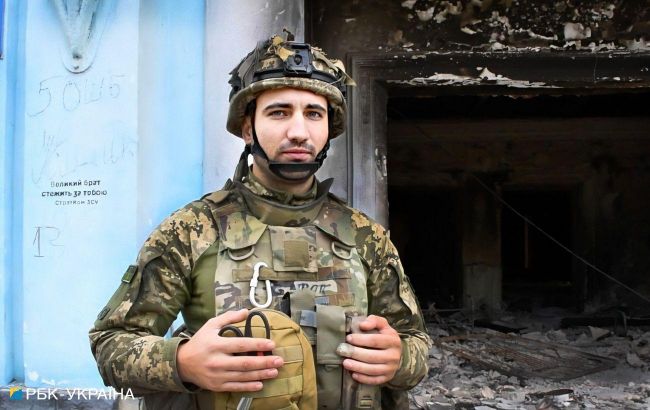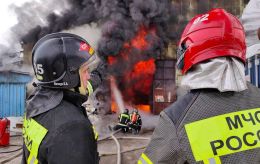Chasiv Yar: How the frontline town survives under the fire and what keeps it going
 Ukrainian Armed Forces serviceman Andrii in Chasiv Yar (All photos: Anastasiia Rokytna)
Ukrainian Armed Forces serviceman Andrii in Chasiv Yar (All photos: Anastasiia Rokytna)
RBC-Ukraine visited Chasiv Yar, Donetsk region, and saw how the small town was living under constant fire, spoke to local residents about what they were waiting for, and discussed the situation on the frontline with the military.
Chasiv Yar, located 10 kilometers from the burning city of Bakhmut, continues to be in the crosshairs of the Russian army. Once known as the "quiet waters" town (the name comes from the Turkic language "Chai-su"), it has now become a site of artillery battles. Before the war, this region was known for its fire-resistant bricks, sandy quarries, and blue lakes, but today the world watches another ravaged Russian-Ukrainian war-torn settlement.
Enemy UAVs, along with artillery, work tirelessly here as locals scatter into buildings in hopes of staying alive. What's happening in the town and whether the situation here affects the Ukrainian counteroffensive near Bakhmut is covered in the RBC-Ukraine report.
***
The road is covered with heavy ash after a vehicle passes through. We don't stop; we move quickly to avoid enemy artillery fire. Shells fly overhead, and the sounds of war are heard every minute.
The small town of Chasiv Yar has turned into a "hell's kitchen" with high risks for everyone residing in it. When Russian forces occupied a significant part of Bakhmut, and the front line shifted, the town began to bear the brunt of heavy weaponry strikes.
As we enter, we can already hear the incoming strike. There is no intact infrastructure left here. Local residents have scattered among the residential buildings, which are their only shelter.
"Are you not afraid to come here?" asks a local resident Lyudmyla.
"Are you not afraid to live here?" we respond with a question.
"No, we just spread out in apartments and are fine. The Russians are hunting for vehicles and cars here," says the woman.
Her house was completely destroyed after an enemy artillery strike. The woman and her son were literally left on the street. She says they were lucky not to be in the house at the time of the strike. After the shelling, her family left without a permanent home. Lyudmyla reluctantly talks about her son but mentions that he is ill. Now they live in a neighboring house where a family friend has provided them with shelter.
"I have a small pension. I can't go anywhere because I have nothing to live on. Right now, the military shares food with us, or volunteers bring humanitarian aid. That's how we survive in these conditions," says Lyudmyla.

Wherever we go, we always hear the stories about the military who share everything with civilians. Chasiv Yar is in the midst of a humanitarian crisis, with no water, no electricity, and problems with food supply. The only ones civilians can rely on in these conditions are the UAF servicepeople and volunteers.
Around 600 people stay here. They all expect to receive a minimal set of clothing and food at the Point of Invincibility. It's an unremarkable building that probably went unnoticed before the invasion. Today, it has become a meeting point for those who have stayed in Chasiv Yar. As we approach it, we hear explosions nearby, one after another. People no longer react to them; they have gotten used to death reigning in this town, and those who haven't been caught in its whirlpool are simply lucky.
Locals are typically emotionless and are used to explosions. Their looks are always suspicious, conveying questions like "Who are you" and "What do you want from me." But Oleksandr stands out from the rest; he smiles and approaches us first.
"What kind of camera do you have? I used to take photos, of friends, and family. But not anymore," he says.
"Why did you stop?"
"Now it's forbidden, during wartime."
His smile doesn't match what's happening around him: chaos, and strikes. Oleksandr tries to be friendly and open. When the conversation turns to family, he becomes tense. The smile fades, and his eyes lose interest. He mentions his granddaughter, who he used to photograph often; now she has left the country because it's safer abroad.
The war has divided tens of thousands of families, turning them into not only political opponents but also soldiers of enemy armies. Propaganda, kilometers of roads, and entire countries have come between these families.
You can drive through all of Chasiv Yar in half an hour; it's a small town. But the caliber of the shells flying into it is large and destructive. Almost all of the town's infrastructure is shattered, and the air is filled with dust, constantly stirred up by Grad missiles or artillery. As we drive through Chasiv Yar, we hear the enemy artillery at work.
"Where is that going?"
"Here."
There's nowhere to hide, especially not here. The Russians are searching for our vehicles, and especially, our artillery. But because it's hidden in an inconvenient position for the enemy, they shell wherever they want, paying no attention to civilians.

Overall, the attitude of the Ukrainian and Russian armies toward civilians differs depending on the goals of the two sides in the war. Ukraine is defending and protecting, while Russia is attempting to capture territory. Right now, counteroffensive actions by Ukrainian forces are ongoing in this direction. However, according to Andrii, a fighter in the International Legion, the frontline has not shifted away from Chasiv Yar, and the shelling continues.
"As you can see, the town is small but constantly under fire. Artillery, MLRS, rockets – everything is here. Our forces also respond in kind. The situation is consistently dangerous," he says.
Andrii is from the Kherson region, where his family is still under occupation. He mentions that before the full-scale war, he was a sailor and used to go on sea voyages. Then the invasion began, and about half a year later, he was mobilized. Today, he is in the International Legion. Changing his sailor's uniform for pixel camouflage, he defends Ukrainian territory and believes that de-occupation will reach his home soon.
Together with Andrii, we stand near the remains of the local Palace of Culture, which served as a humanitarian hub before being hit with cluster bombs. And even earlier, before the major invasion, it was a venue for cultural events and hosting guests. The past is now the atmosphere of a frontline town. People are left with only memories of civilization: recreational spots, educational institutions, or ordinary cafes where one could escape from daily routines. Today, they are gone, and only the fear of becoming the next target of deadly rockets remains.
Hundreds of thousands of defenders work in extremely challenging conditions to preserve people's lives. Families and nearest, and a life without body armor and weapons are waiting for them at home. Despite the fatigue, they continue to follow orders and move forward, but a year and a half of constant battles and chaos take their toll. Partially mobilized individuals replace soldiers who never left the front even before the major invasion. However, Ukraine's human resources are much smaller than those of the enemy state.
Since the beginning of the full-scale war, the General Staff emphasized that our strength lies in the quality of combat rather than quantity. Ukrainians continue to invent various ways of waging war just to protect the lives of their soldiers. This cannot be said for the enemy state, which uses its population as cannon fodder. They have resources for further attacks. In this direction, the Russian army has an advantage in terms of the quantity of weapons and manpower, but it is not enough. Ukrainian defense forces repel assaults and persistently advance.
We leave this town, chasing the last rays of the September sun. We move quickly, avoiding fresh craters on the road from artillery strikes. Ukrainian fighters are confident that there will be no Russian army in Chasiv Yar. They continue to stand as a shield, not allowing Russians into homes in one part of the front and liberating occupied territories in another.

